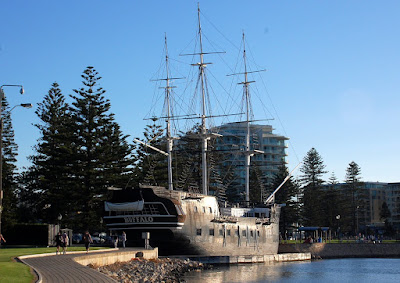 |
| Mount Lofty Ranges from the plane |
Adelaidians are quick to point out that the city was founded as a planned British colony for free immigrants. Following the recommendations of the National Colonization Society, SA settlers purchased the land rather than receiving free grants of land, making the region self-supporting planned colony with no need for subsidies from the British Government. So Adelaide escaped the convict past that defines New South Wales, having spared the settlers the agony of fighting off both the Aboriginals and the convicts. The same free spirit went hand in hand with strong conservative Christian beliefs, which were well-reflected in Australia's immigration policies and handling of the Aboriginals.
 |
| A sketch depicting the free immigrants landing in Glenelg 1839 (Migrants museum, Adelaide) |
 | |
| The Old Gum Tree in Glenelg under which South Australia was proclaimed a state |
After the first rough years, the colony got on its feet thanks to export of wool and wheat, and later, discovery and mining of copper. The waves of immigration brought mostly young married couples from farms in England, Ireland, Scotland, and Germany. A few started developing wineries in the Adelaide Hills and Barossa Valley.
 |
| HMS Buffalo replica in Glenelg |
The biggest city on the south Australian coast, Adelaide is sophisticated, calm, and large enough without being overwhelming. It has a very high standard of living with an average house price of $400,000 (2010), which makes it a very affordable city. There is a wide range of gourmet restaurants catering to local and out-of-state foodies.
 |
| Tour Down Under - an international race that draws spectators from all over the world |
 |
| Australia Day Parade on Jan. 26th celebrates history and diversity of the city |

 | |
| After the parade the crowd sits down for a concert, food, and fireworks that go into the night |


No comments:
Post a Comment